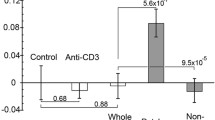Abstract
T cell antigen receptor (TCR) stimulation induces recruitment and accumulation of various types of signaling molecules and forms signaling microclusters. The dynamics of the microclusters are important for regulating the quality and quantity of T cell activation. We describe here our protocols for analysis of signaling microclusters by using supported planar bilayers.
Access this chapter
Tax calculation will be finalised at checkout
Purchases are for personal use only
Similar content being viewed by others
References
Kaye J, Hsu ML, Sauron ME, Jameson SC, Gascoigne NR, Hedrick SM (1989) Selective development of CD4+ T cells in transgenic mice expressing a class II MHC-restricted antigen receptor. Nature 341:746–749
Seder RA, Paul WE, Davis MM, de St. Groth BF (1992) The presence of interleukin 4 during in vitro priming determines the lymphokine-producing potential of CD4+ T cells from T cell receptor transgenic mice. J Exp Med 176:1091–1098
Murphy KM, Heimberger AB, Loh DY (1990) Induction by antigen of intrathymic apoptosis of CD4+CD8+TCRlo thymocytes in vivo. Science 250:1720–1723
Hogquist KA, Jameson SC, Heath WR, Howard JL, Bevan MJ, Carbone FR (1994) T cell receptor antagonist peptides induce positive selection. Cell 76:17–27
Kitamura T (1998) New experimental approaches in retrovirus-mediated expression screening. Int J Hematol 67:351–359
Morita S, Kojima T, Kitamura T (2000) Plat-E: an efficient and stable system for transient packaging of retroviruses. Gene Ther 7:1063–1066
Yokosuka T, Kobayashi W, Sakata-Sogawa K, Takamatsu M, Hashimoto-Tane A, Dustin ML, Tokunaga M, Saito T (2008) Spatiotemporal regulation of T cell costimulation by TCR-CD28 microclusters and protein kinase C theta translocation. Immunity 29:589–601
Yokosuka T, Kobayashi W, Takamatsu M, Sakata-Sogawa K, Zeng H, Hashimoto-Tane A, Yagita H, Tokunaga M, Saito T (2010) Spatiotemporal basis of CTLA-4 costimulatory molecule-mediated negative regulation of T cell activation. Immunity 33:326–339
Yokosuka T, Takamatsu M, Kobayashi-Imanishi W, Hashimoto-Tane A, Azuma M, Saito T (2012) Programmed cell death 1 forms negative costimulatory microclusters that directly inhibit T cell receptor signaling by recruiting phosphatase SHP2. J Exp Med 209:1201–1217
Hashimoto-Tane A, Sakuma M, Ike H, Yokosuka T, Kimura Y, Ohara O, Saito T (2016) Micro adhesion rings surrounding TCR microclusters are essential for T cell activation. J Exp Med 213(8):1609–1625
Hashimoto-Tane A, Yokosuka T, Sakata-Sogawa K, Sakuma M, Ishihara C, Tokunaga M, Saito T (2011) Dynein-driven transport of T cell receptor microclusters regulates immune synapse formation and T cell activation. Immunity 34:919–931
Hashimoto-Tane A, Yokosuka T, Ishihara C, Sakuma M, Kobayashi W, Saito T (2010) T-cell receptor microclusters critical for T-cell activation are formed independently of lipid raft clustering. Mol Cell Biol 30:3421–3429
Yokosuka T, Sakata-Sogawa K, Kobayashi W, Hiroshima M, Hashimoto-Tane A, Tokunaga M, Dustin ML, Saito T (2005) Newly generated T cell receptor microclusters initiate and sustain T cell activation by recruitment of Zap70 and SLP-76. Nat Immunol 6:1253–1262
Grakoui A, Bromley SK, Sumen C, Davis MM, Shaw AS, Allen PM, Dustin ML (1999) The immunological synapse: a molecular machine controlling T cell activation. Science 285:221–222
Acknowledgment
This work was supported by KAKENHI (Grant-in-Aid for Scientific Research (S) 24229004 for T.S. and (C) 10415226 for A.H.-T.), and partly by Takeda Science Foundation, Novartis Foundation (Japan), and Hayashi Memorial Foundation for Female Natural Scientists.
Author information
Authors and Affiliations
Corresponding author
Editor information
Editors and Affiliations
Rights and permissions
Copyright information
© 2017 Springer Science+Business Media LLC
About this protocol
Cite this protocol
Hashimoto-Tane, A., Yokosuka, T., Saito, T. (2017). Analyzing the Dynamics of Signaling Microclusters. In: Baldari, C., Dustin, M. (eds) The Immune Synapse. Methods in Molecular Biology, vol 1584. Humana Press, New York, NY. https://doi.org/10.1007/978-1-4939-6881-7_4
Download citation
DOI: https://doi.org/10.1007/978-1-4939-6881-7_4
Published:
Publisher Name: Humana Press, New York, NY
Print ISBN: 978-1-4939-6879-4
Online ISBN: 978-1-4939-6881-7
eBook Packages: Springer Protocols




